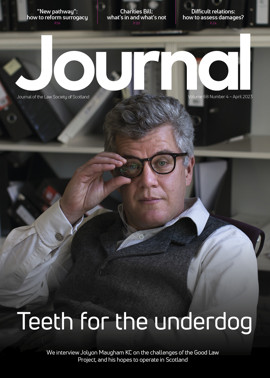Valuing the not so close

The right of the relatives of a person killed as a result of another’s negligence to seek damages has long been part of Scots law. The current law is found in the Damages (Scotland) Act 2011. This allows certain relatives to make claims for patrimonial and non-patrimonial losses. The scope of this comment is restricted to considering awards for non-patrimonial losses, commonly referred to as “loss of society” awards, made under s 4(3) of the Act.
The categories of relatives able to make such claims are set out in s 14. These are limited to the deceased’s immediate family, including spouse, civil partner or cohabitee, parents, grandparents, children and grandchildren. The Act makes no distinction from relationships that arise from consanguinity, adoption or stepfamilies, and it extends to persons who were accepted by the deceased as being such a relative. Anyone who falls within those categories has a right to bring a claim.
While there is a rough hierarchy that arises from the ranges of common awards, certain relatives tend to get higher awards than others. For example, a bereaved civil partner is likely to be awarded more than a sibling. These lines have become rather blurred, particularly when a court has considered awards to children and grandchildren. While there are general factors, such as the age of the deceased and their life expectancy, that will affect any awards made, recent case law has made it clear that the significant factor the court will consider is the closeness of the relationship. This has seen grandchildren whose evidence was that a deceased grandparent filled a parental role receive awards on a similar level to those made to children in other cases. In general, a closer relationship will result in a higher award from the court. In some older cases brought under the Damages (Scotland) Act 1976, distinctions were drawn between children living at home and those that had moved out: Morrison v Forsyth 1995 SLT 539; Sargent v Secretary of State for Scotland 2000 GWD 28-1089, although no such distinction was drawn in McManus v Babcock Energy Ltd 1999 SC 569.
Judicial approaches
Practitioners familiar with fatal claims are likely to have seen families ranging from those whose relationships are very close through to families who have had little or no recent contact, or on some occasions, ongoing conflict between family members. In cases like these, approaching s 4(3) claims can be very difficult, both in terms of dealing with the various family members and providing advice regarding their claims.
Some of the concerns arise from very low awards made to very young grandchildren. By a jury in Kelly v Upper Clyde Shipbuilders (in liquidation) 2012 Rep B 107-6, grandchildren aged 14 were awarded £8,000, while younger grandchildren aged seven and two were awarded £4,000 and £1,500 respectively. A similar distinction was drawn in Gallagher v SC Cheadle Hume Ltd 2015 Rep LR 33, where two elder grandchildren were awarded £25,000, and three others £12,000. The youngest grandchildren, respectively aged two years and less than three months, were only awarded £2,500.
Lord Uist in making his decision relied on McGee v RJK Building Services Ltd 2013 SLT 428, albeit the specific question of very young grandchildren did not arise in that case. A rough inference that could be drawn is that the courts put significant weight on an existing relationship, and the possibility of closeness in the future is of less import when assessing an award – though this is very different from the approach taken in the slightly earlier case of Stuart v Reid 2014 Rep LR 107, where Lord Woolman made an award of £14,000 to a grandchild (age not given) and apportioned it wholly to the future, accepting that he had been deprived of the deceased’s guidance for 15 years (the agreed life expectancy).
This created a difficulty in providing advice regarding the value of their case to pursuers who had had a limited relationship with the deceased. Broadly speaking, the extent of the relationship would be a determining factor in making any award. The question is, how would a court approach a difficult or non-existent relationship? Would pursuers who had fallen out and not spoken to a deceased for years still have a statable claim? To what extent would a historic good relationship between a child and a parent, severed by a falling out and the loss of any possibility of future reconciliation, sway a court? Stuart would suggest that a future closer relationship could be a significant factor, albeit in a case with a difficult relationship this might only amount to the loss of a chance of a close relationship, while the awards in Gallagher, read along with Morrison, could be taken to support a court placing greater reliance on past and current relationships.
Recent guidance
The recent decision from Lord Arthurson in Paterson v Lanarkshire Health Board [2023] CSOH 1, insofar as it relates to the second and third pursuers (the deceased’s brother, and stepsister respectively), gives some guidance as to how a court may approach more difficult family relationships.
It was a very tragic clinical negligence case centring around treatment for the deceased’s psychiatric condition and her subsequent suicide aged 35. The question of liability takes up much of the written decision. An award of £100,000 under s 4(3) of the 2011 Act was made to the deceased’s mother, the first pursuer. The fourth and fifth pursuers, the deceased’s children, aged 20 and 22 at the date of decision (13 and 15 at the time of the death), were each awarded £70,000. The opinion does not set out the evidence of the family relationships for the first, fourth and fifth pursuers in any great detail, but Lord Arthurson refers to these pursuers as “beloved” in para 1.
Turning to the treatment of the second and third pursuers, their evidence is not set out in detail, but it is recorded in para 1 that the deceased and her brother and stepsister were “in large part estranged due to a family rift”. In para 61, Lord Arthurson describes the relationship as “very distant”, and refers to medical notes that recorded that the deceased had been ostracised by members of her family. His Lordship was of the view that this included the second and third pursuers. Lord Arthurson specifically notes that the second pursuer did not return to court to finish his evidence, and that he had struggled to recall the time of year that the deceased had died. In respect of the third pursuer, he noted she had only lived with the deceased for a very short period and there was a sizable age gap of 16 years. The awards made to these pursuers were £5,000 each inclusive of interest. The deceased’s death occurred on 10 October 2016, so given the passage of time and assuming usual interest at 4% the net award before interest was in the region of £4,000. This is a very reduced award compared to other recent cases dealing with bereaved siblings. In McCulloch v Forth Valley Health Board [2020] CSOH 40 the agreed quantum for the sister of a deceased aged 39 was £25,000. In McArthur v Timberbush Tours [2021] CSOH 75 the judicial award made to a half-sister who had a very close relationship with the deceased aged 26 at death was £45,000. In Currie v Esure Services Ltd 2014 SLT 631 (OH), a brother was awarded £22,500. This reinforces the approach that the courts take by putting significant reliance on the nature and closeness of the relationship.
While the opinion in Paterson does not explore the relationships in detail, there is enough there to infer that these were not close. The court accepted that both the second and third pursuers were estranged from the deceased.
This decision is helpful to both pursuers and defenders, as it does give some assistance in respect of claims for difficult family relations. For pursuers it shows that even where a relationship is one of estrangement, the courts will make an award that is significantly more than a token. For defenders, it shows that such awards are likely to be much reduced compared to awards for closer family relationships. The important thing for both sides is to be aware and investigate the family relationships as far as possible when presenting or defending such claims.
Questions remain about how the courts may approach similar situations, for example a feuding family, but it appears likely that where there has at some point been some sort of relationship, an award will be made.
Dispensing with service
A broader issue that arises for practitioners from the Paterson case is the terms of RCS, rules 43.14 and 43.16 in the Court of Session, and OCR, rules 36.2 and 36.4 in the sheriff court. These govern the need to plead the existence of connected persons and the obligation to intimate the proceedings on any persons who may have an interest in the action.
A pursuer needs to set it out where the names and whereabouts of such persons are not known and cannot be reasonably ascertained, or where the likely claim would be under £200. The pursuer can then apply to the court to ask that intimation be dispensed with. The concern in this respect raised by Paterson is that given the level of awards made, whether to the second pursuer who was estranged and had a distant relationship with the deceased, or the third pursuer who was estranged and who could be read as having a limited relationship, were still significantly more than the £200 set out in the court rules. Practitioners should be very cautious when making applications to dispense with service on the basis of RCS, rule 43.14(2)(c)(ii) or OCR, rule 36.2(c)(ii), as even awards for very limited relationships are likely to exceed that limit.
Perspectives
Features
Briefings
- Criminal court: Towards proper control
- Planning: NPF4 – an emerging housing issue
- Insolvency: Court confirms overseas winding up approach
- Tax: R&D relief – welcome changes but outlook uncertain
- Immigration: Family reunions given new rules
- Scottish Solicitors' Discipline Tribunal
- In-house: Support to suit







